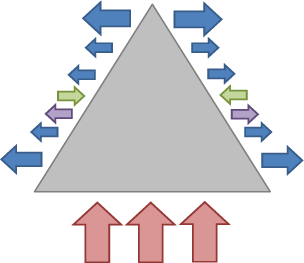Age structures and demographic events (cont.)
The relationship between age structures and demographic processes
The age (and sex) structure of a population is determined by three demographic processes: births, deaths and migration. For the purposes of this session we will only consider closed populations, i.e. those with no migration.
Closed population age structures change when fertility and mortality rates change. If there is no change in these demographic processes over a long period of time, the age-sex structure of the population will no longer change and the population will become stable.

This diagram represents the processes which affect population size and structure. Deaths (blue arrows) remove people from a population at every age, although the number of deaths occurring is both age and sex dependent. Births (red arrows) add people to the population, but only at age 0. Immigration (green arrows) can add people to the population at any age, and emigration (purple arrows) can remove people from the population at any age. Both immigration and emigration tend to be patterned by age and sex.
In turn, the age-sex structure of a population determines the number of births and deaths occurring. This is because both processes are strongly related to age, with some people more at risk of the vital event happening to them than others.
The following pages describe the relationship between a given demographic process and the age-sex structure, starting with fertility.